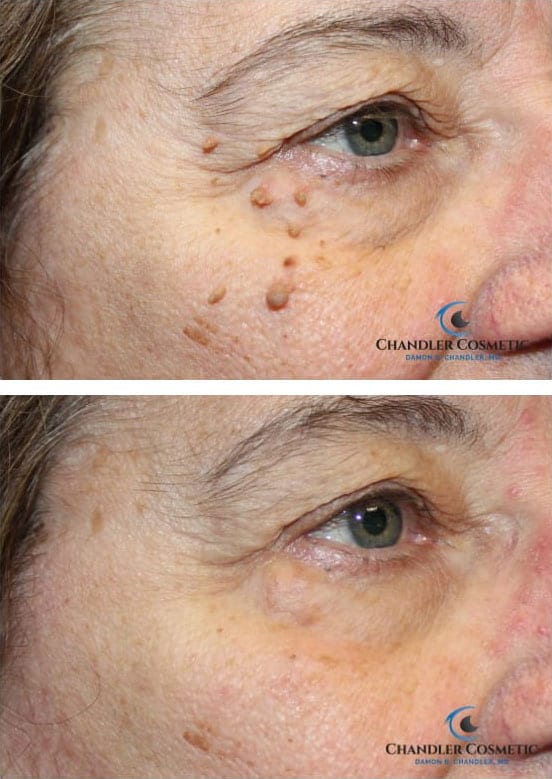Which Areas of the Eyelid Are Most Prone to Skin Tags?
Uncover the facts about eyelid skin tags, their formation, and management strategies. Stay informed on how to keep the area clean and monitor any changes.

Introduction:
Eyelid skin tags are minor, mild bumps that frequently look on the soft skin of the eyelids. They can be diverse sizes but typically don’t cause any complications, though they might be cosmetic anxiety or cause mild uneasiness. Knowing which parts of the eyelid are more likely to get skin tags can aid with prevention and treatment. The continuous movement of the eyelids, along with aspects like aging, family history, or hormone variations, can make these growths more possible. These areas are common places for eyelid skin tags to appear.
Common places where skin tags can form on the eyelids:
Upper Eyelid Edge: Skin tags can form close to the top of the eyelid, close to the lashes.
Lower Eyelid near the Lashes: Skin tags can look near the bottom lashes.
Inner Corners of the Eyes: Skin tags can display where the upper and lower eyelids meet in the inner corner.
Outer Eyelid Fold: Skin tags can look near the outer fold of the eyelid.
Underneath the Eyelid: Skin tags may form below the eyelid, under the lashes.
Upper Eyelid Margin
The upper eyelid is more likely to develop skin tags as it moves a lot when you blink, causing the skin to rub organized. Each time you blink, the skin stretches and folds, and this can lead to minor growth over time. People with fatigued eyelids or additional skin around their eyes are in greater danger as the folds rub against each other more. Other aspects like getting older, family past, and too much sun can weaken the skin, making it easier for skin tags to form. Using lotions or questioning a doctor for guidance can aid in stopping these skin growths.
Lower Eyelid Close to the Lash Line
Skin tags frequently appear on the lower eyelid close to the lash line. This area has subtle skin that can get annoyed from touching, rubbing, or applying makeup. Repeatedly touching this part of the face can make it more likely for skin tags to form. People with eye allergies who rub their eyes more frequently are also in greater danger. The skin around the eyes is thinner and sensitive so that continuous irritation can lead to small skin growths.
Inner Corners of the Eyes (Medial Canthus)
The medial canthus is the inner corner of the eye where the top and bottom eyelids meet. It’s a deep and moist area where the skin certainly folds. This creates a place where skin tags, minor soft growths, can form. Skin tags frequently happen for rubbing, dampness, and warmth. People with conditions like diabetes or obesity are more likely to get skin tags in this area. These conditions can disturb the skin, making skin tags more possible.
Outer Eyelid Crease (Lateral Canthus)
The outer eyelid crease moves a lot when you smile, squint, or blink. This continuous movement can put pressure on the skin, leading to the creation of skin tags. Skin tags are minor, soft bumps that form where skin rubs against itself or other surfaces. As people get older, their skin drops its ability to stretch and bounce back, making it stress-free for skin tags to form, particularly in areas like the eyelids. While skin tags are typically harmless, they can sometimes be irritating or cause uneasiness.
Underneath the Eyelids (Subtarsal Area)
Even though it’s not very common, skin tags can sometimes look under the eyelid, particularly in people who frequently wear contact lenses or have dry eyes. The rubbing or friction between the eyelid and the eye can cause annoyance, which may lead to skin tags. The area below the eyelid is subtle, and things like rubbing or rubbing the eyes or wearing contact lenses can cause these small growths. While skin tags here are rare, they are more likely to form in people who have continuing annoyance.
Conclusion
To conclude, eyelid skin tags are mild growths that can cause uneasiness or make you feel self-conscious depending on their size and where they are. They typically show up on the upper or lower eyelids, particularly at the corners, but sometimes they can look underneath the eyelids. These skin tags frequently form due to rubbing, annoyance, or skin folding. To manage them, it’s important to keep the area clean, avoid rubbing your eyes too much, and watch for any variations.

 chandlercosmetic
chandlercosmetic